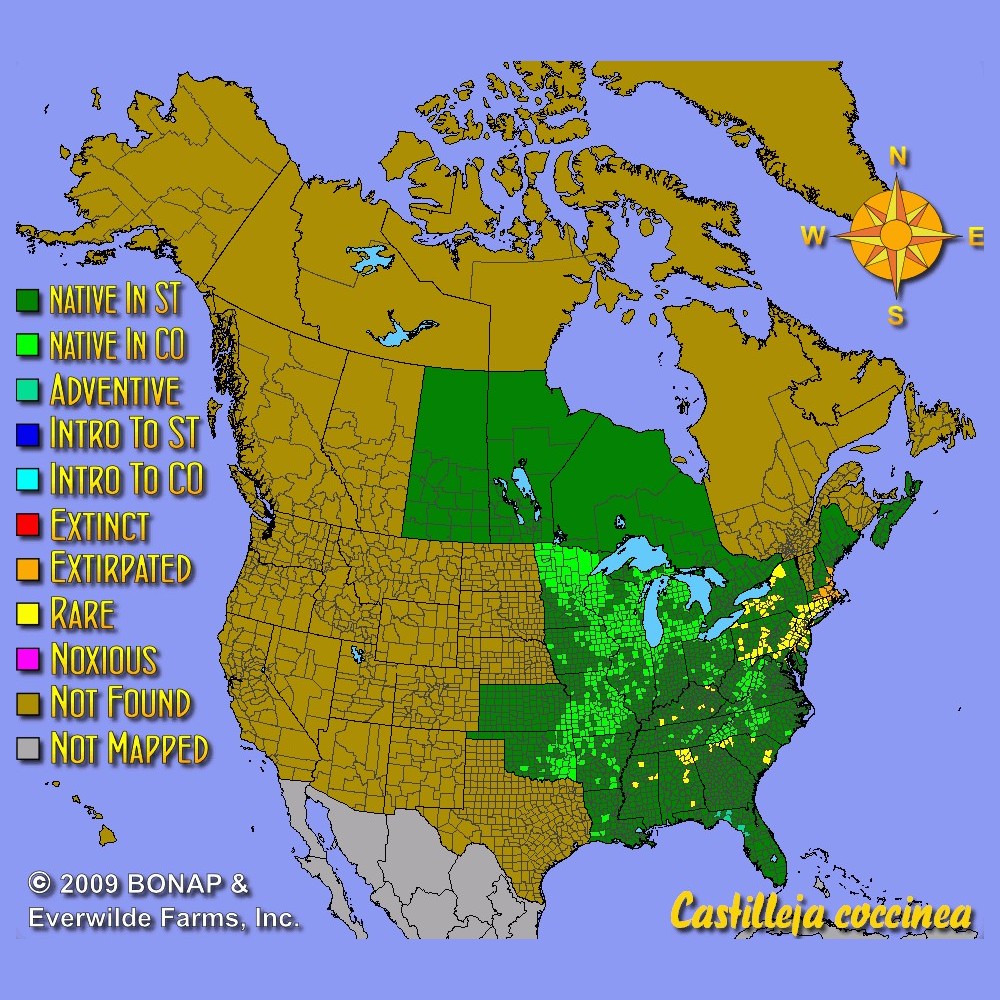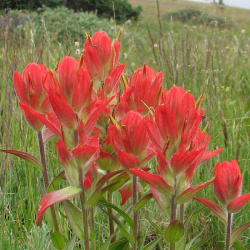Indian Paintbrush Seeds
- HOW TO GROW
- FAST FACTS
- REVIEWS
HOW TO GROW
Sowing: To break its dormancy, this seed needs to be stratified; mix the seed with moist sand and store it in the refrigerator for 60-90 days before planting. In the spring, plant the seed on the surface of loose soil at the base of a larger plant. Since this plant is hemiparasitic, it needs a "host" plant to aid it in receiving necessary nutrients from the soil. For fall planting, sow untreated seed on the surface of loose soil near other plants, or sow a low-growing native grass along with the seed. This plant seems to grow well with Penstemon, as well as various native, low growing grasses and sedges. Germination may be slow and irregular. Transplanting is not reccomended.
Growing: This plant prefers sandy or average soil, but also adapts well to rather moist soil with good drainage. It develops rather slowly and will not bloom until its second year. Since seedlings are very sensitive to drought, water them evenly and regularly during their first season; mature plants may also need occasional watering, since they do not tolerate extensive drought. This plant will wither and die once its seed has been produced, but volunteer seedlings may grow from dropped seed. This plant attracts hummingbirds, butterflies, and bees. They are rather difficult to grow in the garden, but make a lovely addition to prairie plantings or native meadows.
Harvesting: This rare wildflower is best displayed in the garden or prairie, where it will develop seed to preserve its growth for future generations. Keep in mind that its leaves are highly toxic.
Seed Saving: Small pods will form at the tops of the stalks. These pods will split and release their seeds when dry, and should be harvested before that point. As soon as the pods begin to feel dry and start to turn color, remove them and spread them out to dry. Thresh the dried pods to remove the seed. Store the seed in a cool, dry place.
FAST FACTS
Common Names: Scarlet Indian Paintbrush
Latin Name: Castilleja coccinea
Species Origin: US Native Wildflower
Type: Native Wildflowers
Life Cycle: Biennial
USDA Zones: 3, 4, 5, 6, 7, 8, 9
US Regions: Plains/Texas, Midwest, Northern, Northeast, Southeast
Seeds per Ounce: 300,000
Stratification: Cold/Wet for 8 Weeks
Germination Ease: Stratify 8 Weeks
Sunlight: Full Sun, Part Sun
Height: 18 Inches
Color: Red, Yellow
Bloom Season: Blooms Early Spring, Blooms Late Spring, Blooms Early Fall
Fast , Easy and Beautiful
I was so excited about my order for my seeds. Great News, unlike so many other places , they were prompt and fast delivery. Service was great!
Excited to Plant
I have been searching for quite sometime to find these seeds. I live part time in Wyoming and wanted to bring these to my home in Nashville. Love the packaging.
DESCRIPTION

HOW TO GROW
Sowing: To break its dormancy, this seed needs to be stratified; mix the seed with moist sand and store it in the refrigerator for 60-90 days before planting. In the spring, plant the seed on the surface of loose soil at the base of a larger plant. Since this plant is hemiparasitic, it needs a "host" plant to aid it in receiving necessary nutrients from the soil. For fall planting, sow untreated seed on the surface of loose soil near other plants, or sow a low-growing native grass along with the seed. This plant seems to grow well with Penstemon, as well as various native, low growing grasses and sedges. Germination may be slow and irregular. Transplanting is not reccomended.
Growing: This plant prefers sandy or average soil, but also adapts well to rather moist soil with good drainage. It develops rather slowly and will not bloom until its second year. Since seedlings are very sensitive to drought, water them evenly and regularly during their first season; mature plants may also need occasional watering, since they do not tolerate extensive drought. This plant will wither and die once its seed has been produced, but volunteer seedlings may grow from dropped seed. This plant attracts hummingbirds, butterflies, and bees. They are rather difficult to grow in the garden, but make a lovely addition to prairie plantings or native meadows.
Harvesting: This rare wildflower is best displayed in the garden or prairie, where it will develop seed to preserve its growth for future generations. Keep in mind that its leaves are highly toxic.
Seed Saving: Small pods will form at the tops of the stalks. These pods will split and release their seeds when dry, and should be harvested before that point. As soon as the pods begin to feel dry and start to turn color, remove them and spread them out to dry. Thresh the dried pods to remove the seed. Store the seed in a cool, dry place.
FAST FACTS
Common Names: Scarlet Indian Paintbrush
Latin Name: Castilleja coccinea
Species Origin: US Native Wildflower
Type: Native Wildflowers
Life Cycle: Biennial
USDA Zones: 3, 4, 5, 6, 7, 8, 9
US Regions: Plains/Texas, Midwest, Northern, Northeast, Southeast
Seeds per Ounce: 300,000
Stratification: Cold/Wet for 8 Weeks
Germination Ease: Stratify 8 Weeks
Sunlight: Full Sun, Part Sun
Height: 18 Inches
Color: Red, Yellow
Bloom Season: Blooms Early Spring, Blooms Late Spring, Blooms Early Fall
Reviews
Review
Fast , Easy and Beautiful
I was so excited about my order for my seeds. Great News, unlike so many other places , they were prompt and fast delivery. Service was great!
Review
Excited to Plant
I have been searching for quite sometime to find these seeds. I live part time in Wyoming and wanted to bring these to my home in Nashville. Love the packaging.
Also Consider These:
-
 Out Of Stock
Wholeleaf Indian Paintbrush Seeds
Castilleja integra
This spiky orange-red flower is one of the larger varieties of Paintbrush. This native perennial does best in gravelly soil and seems to enjoy the dry heat of the American West.Quick Viewx
Out Of Stock
Wholeleaf Indian Paintbrush Seeds
Castilleja integra
This spiky orange-red flower is one of the larger varieties of Paintbrush. This native perennial does best in gravelly soil and seems to enjoy the dry heat of the American West.Quick ViewxWholeleaf Indian Paintbrush Seeds
Castilleja integra
This spiky orange-red flower is one of the larger varieties of Paintbrush. This native perennial does best in gravelly soil and seems to enjoy the dry heat of the American West.
$3.48 Pkt - $15.95 / Oz







